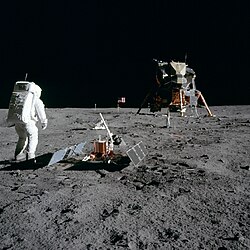
A moonbase (or lunar base) is a human outpost on or below the surface of the Moon.[1] More than a mere site of activity or temporary camp, moonbases are extraterrestrial bases, supporting robotic or human activity, by providing surface infrastructure. Missions to the Moon have realized single-mission bases, (Tranquility Base being the first), as well as some small permanent infrastructure like lunar laser ranging installations.
Plans for establishing moonbases, with surface or sub-surface research stations, have been proposed and are actively pursued nationally and increasingly internationally. As of 2024, the two most advanced projects to set up moonbases have been pursued multilaterally as part of the US-led Artemis program, with its planned Artemis Base Camp and as the China-led International Lunar Research Station.[2] A broader, international infrastructure has been envisioned with the so-called Moon Village concept, and a general international regulatory regime for lunar activity has been called for by the 1979 signed Moon Treaty, and advocated for with an implementation agreement since 2020.[3][4]
The surface infrastructure of a base may consist of pre-integrated basic landers, as supporting stations for robotic rovers, or habitation modules for crewed presence, or of surface assembled or in-situ derived and constructed surface stations for sustained lunar habitation.[1] Lunar bases may work with lunar space stations, which in contrast provide infrastructures in lunar orbit supporting activity from there, as with the planned Lunar Gateway of the Artemis program.
The development of moonbases into permanent extraterrestrial settlements has been put forward.[1][5] Broader lunar colonization or space colonization in general, particularly as laying territorial claims, which is prohibited by international space law, has been criticized for perpetuating colonialism.[6]
- ^ a b c Kennedy, Kriss; Toups, Larry; Smitherman, David (2007-09-18). Lunar Habitation Strategies. American Institute of Aeronautics and Astronautics. doi:10.2514/6.2007-6275. ISBN 978-1-62410-016-1.
- ^ Dangwal, Ashish (2023-11-22). "1st Country With Lunar Outpost, Competition 'Heating-Up' Between US-Led Artemis & China's ILRS". Latest Asian, Middle-East, EurAsian, Indian News. Retrieved 2024-05-05.
- ^ "The Space Review: The Artemis Accords: repeating the mistakes of the Age of Exploration". The Space Review. June 29, 2020. Archived from the original on January 25, 2022. Retrieved February 1, 2022.
- ^ "The Space Treaty Institute – Dedicated to Peace and Sustainability in Outer Space. Our Mission: To give people Hope and Inspiration by helping the nations of Earth to build a Common Future". The Space Treaty Institute – Dedicated to Peace and Sustainability in Outer Space. Our Mission. Archived from the original on February 1, 2022. Retrieved February 1, 2022.
- ^ "Lunar Bases and Settlements – NSS". NSS – The National Space Society. 2023-12-05. Retrieved 2024-05-19.
- ^ Wall, Mike (2019-10-25). "Bill Nye: It's Space Settlement, Not Colonization". Space.com. Retrieved 2023-06-14.